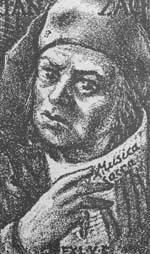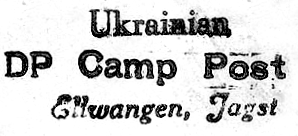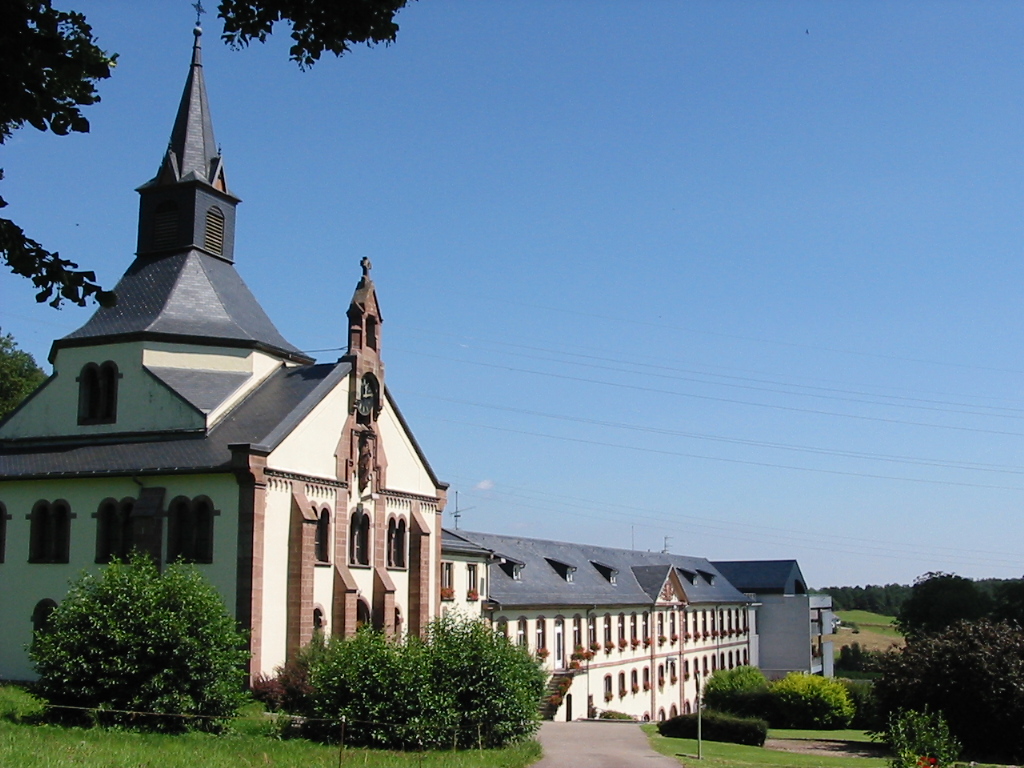|
Jan Zach
Jan Zach, called in German Johann Zach (baptized 26 November 1713 – 24 May 1773) was a Czech composer, violinist and organist. Although he was a gifted and versatile composer capable of writing both in Baroque and Classical idioms, his eccentric personality led to numerous conflicts and lack of steady employment from about 1756 onwards. Life Zach was born in Dehtáry near Brandýs nad Labem, Bohemia into a wheelwright's family. In 1724 he moved to Prague and started working as violinist at St Gallus and at St Martín. According to Dlabacž, he studied organ under Bohuslav Matěj Černohorský, who lived in Prague from 1720 to 1727. Zach's career as organist started at St Martín, and by 1737 he was also playing the organ at the monastic church of the Merciful Brethren and the Minorite chapel of St Ann. In 1737 he competed for the position of organist at St. Vitus Cathedral, but was not successful. Details of what happened next are unknown: he was reported to have left Bohemia, ... [...More Info...] [...Related Items...] OR: [Wikipedia] [Google] [Baidu] |
Jan Zach
Jan Zach, called in German Johann Zach (baptized 26 November 1713 – 24 May 1773) was a Czech composer, violinist and organist. Although he was a gifted and versatile composer capable of writing both in Baroque and Classical idioms, his eccentric personality led to numerous conflicts and lack of steady employment from about 1756 onwards. Life Zach was born in Dehtáry near Brandýs nad Labem, Bohemia into a wheelwright's family. In 1724 he moved to Prague and started working as violinist at St Gallus and at St Martín. According to Dlabacž, he studied organ under Bohuslav Matěj Černohorský, who lived in Prague from 1720 to 1727. Zach's career as organist started at St Martín, and by 1737 he was also playing the organ at the monastic church of the Merciful Brethren and the Minorite chapel of St Ann. In 1737 he competed for the position of organist at St. Vitus Cathedral, but was not successful. Details of what happened next are unknown: he was reported to have left Bohemia, ... [...More Info...] [...Related Items...] OR: [Wikipedia] [Google] [Baidu] |
Johann Friedrich Karl Von Ostein
Johann Friedrich Karl von Ostein (6 July 1689 – 4 June 1763) was the Prince-Bishop of Worms, Archbishop of Mainz and Elector of Mainz. Early life He was born as the eldest son of Count Johann Franz Sebastian von Ostein (1652-1718) and his wife, Countess Anna Karolina Maria von Schönborn (1671-1746). Biography He was a relative of Lothar Franz von Schönborn, a prior Archbishop-Elector of Mainz. On 22 April 1743 he was selected as a compromise candidate for Archbishop. His rule was overshadowed by the War of the Austrian Succession, Seven Years' War and subsequent peace treaty. Having supported the losing side in the Seven Years' War, the cost of reparations bankrupted Mainz. A new mansion, Osteiner Hof was built along the Diethmarkt, now Schillerplatz, as his principal residence. The town experienced at Osteins time big changes. The electoral palace was largely completed in 1752. In addition, the new buildings of St. Peter's and the Jesuit church were built, as well as ... [...More Info...] [...Related Items...] OR: [Wikipedia] [Google] [Baidu] |
Cistercians
The Cistercians, () officially the Order of Cistercians ( la, (Sacer) Ordo Cisterciensis, abbreviated as OCist or SOCist), are a Catholic religious order of monks and nuns that branched off from the Benedictines and follow the Rule of Saint Benedict, as well as the contributions of the highly-influential Saint Bernard of Clairvaux, known as the Latin Rule. They are also known as Bernardines, after Saint Bernard himself, or as White Monks, in reference to the colour of the "cuculla" or cowl (choir robe) worn by the Cistercians over their habits, as opposed to the black cowl worn by Benedictines. The term ''Cistercian'' derives from ''Cistercium,'' the Latin name for the locale of Cîteaux, near Dijon in eastern France. It was here that a group of Benedictine monks from the monastery of Molesme founded Cîteaux Abbey in 1098, with the goal of following more closely the Rule of Saint Benedict. The best known of them were Robert of Molesme, Alberic of Cîteaux and the English ... [...More Info...] [...Related Items...] OR: [Wikipedia] [Google] [Baidu] |
Ellwangen
Ellwangen an der Jagst, officially Ellwangen (Jagst), in common use simply Ellwangen () is a town in the district of Ostalbkreis in the east of Baden-Württemberg in Germany. It is situated about north of Aalen. Ellwangen has 25,000 inhabitants. Geography Ellwangen is situated in the valley of the river Jagst, between the foothills of the Swabian Alb and Virngrund (ancient Virgundia) forest, the latter being part of the Swabian-Franconian Forest. The Jagst runs through Ellwangen from south to north. History The town developed in the 7th century as an Alemannic settlement in the Virgunna forest next to the Franconian-Swabian border. In 764 the Frankish noble Hariolf, Bishop of Langres, founded a Benedictine monastery, Ellwangen Abbey, on a hill next to the settlement. The monastery was mentioned in a document of Louis the Pious as ''Elehenuuwang'' in 814. It became a ''Reichsabtei'' in 817. From 870 to 873 the Byzantine Greek "Apostle of the Slavs" Saint Methodius was imprison ... [...More Info...] [...Related Items...] OR: [Wikipedia] [Google] [Baidu] |
Frankfurt
Frankfurt, officially Frankfurt am Main (; Hessian: , "Frank ford on the Main"), is the most populous city in the German state of Hesse. Its 791,000 inhabitants as of 2022 make it the fifth-most populous city in Germany. Located on its namesake Main River, it forms a continuous conurbation with the neighboring city of Offenbach am Main and its urban area has a population of over 2.3 million. The city is the heart of the larger Rhine-Main metropolitan region, which has a population of more than 5.6 million and is Germany's second-largest metropolitan region after the Rhine-Ruhr region. Frankfurt's central business district, the Bankenviertel, lies about northwest of the geographic center of the EU at Gadheim, Lower Franconia. Like France and Franconia, the city is named after the Franks. Frankfurt is the largest city in the Rhine Franconian dialect area. Frankfurt was a city state, the Free City of Frankfurt, for nearly five centuries, and was one of the most import ... [...More Info...] [...Related Items...] OR: [Wikipedia] [Google] [Baidu] |
Wallerstein, Bavaria
Wallerstein is a municipality and former principality in the district of Donau-Ries in Bavaria in Germany. It was first mentioned in 1238 as Steinheim. For generations ruled by the House of Oettingen-Wallerstein, in 1806 Wallerstein became part of the Kingdom of Bavaria by the process of mediatisation. The family still owns the Wallerstein Castle and its surrounding land. Mayors * 1972-2002: Manfred Schürer *since 2002: Joseph Mayer Culture and Sights * Castle Wallerstein * Castle rock * Old Jewish burial ground * One of only three German Marian and Holy Trinity columns Gallery Wallerstein, die Pestsäule DmD-7-79-224-7 en die katholische Pfarrkirche Sankt Alban DmD-7-79-224-1 foto5 2016-08-04 09.39.jpg, Wallerstein, monument (die Pestsäule) and Catholic Parish Church of Saint Alban File:St. Oswald Kirche Ehringen - panoramio.jpg, St. Oswald Church Notable inhabitants * Yom-Tov Lipmann Heller (1579-1654), born in Wallerstein and later Rabbi of Prague, Nemirow and K ... [...More Info...] [...Related Items...] OR: [Wikipedia] [Google] [Baidu] |
Munich
Munich ( ; german: München ; bar, Minga ) is the capital and most populous city of the States of Germany, German state of Bavaria. With a population of 1,558,395 inhabitants as of 31 July 2020, it is the List of cities in Germany by population, third-largest city in Germany, after Berlin and Hamburg, and thus the largest which does not constitute its own state, as well as the List of cities in the European Union by population within city limits, 11th-largest city in the European Union. The Munich Metropolitan Region, city's metropolitan region is home to 6 million people. Straddling the banks of the River Isar (a tributary of the Danube) north of the Northern Limestone Alps, Bavarian Alps, Munich is the seat of the Bavarian Regierungsbezirk, administrative region of Upper Bavaria, while being the population density, most densely populated municipality in Germany (4,500 people per km2). Munich is the second-largest city in the Bavarian dialects, Bavarian dialect area, ... [...More Info...] [...Related Items...] OR: [Wikipedia] [Google] [Baidu] |
County Of Tyrol
The (Princely) County of Tyrol was an estate of the Holy Roman Empire established about 1140. After 1253, it was ruled by the House of Gorizia and from 1363 by the House of Habsburg. In 1804, the County of Tyrol, unified with the secularised prince-bishoprics of Trent and Brixen, became a crown land of the Austrian Empire. From 1867, it was a Cisleithanian crown land of Austria-Hungary. Today the territory of the historic crown land is divided between the Italian autonomous region of Trentino-Alto Adige/Südtirol and the Austrian state of Tyrol. The two parts are today associated again in the Tyrol–South Tyrol–Trentino Euroregion. History Establishment At least since German king Otto I had conquered the former Lombard kingdom of Italy in 961 and had himself crowned Holy Roman Emperor in Rome, the principal passes of the Eastern Alps had become an important transit area. The German monarchs regularly travelled across Brenner or Reschen Pass on their Italian expedi ... [...More Info...] [...Related Items...] OR: [Wikipedia] [Google] [Baidu] |
Stams
Stams is a municipality in Imst District, in the Austrian state of Tyrol. It is chiefly known for Cistercian Stams Abbey (''Stift Stams''), founded in 1273 by Count Meinhard II of Gorizia-Tyrol and his wife.Chizzali. ''Tyrol: Impressions of Tyrol.'' (Innsbruck: Alpina Printers and Publishers), p. 64 Geography Stams is located on the southern shore of the Inn River about east of Imst, west of Telfs and west of the state capital Innsbruck. The village contains Stams has 1300 inhabitants who are living in different parts of the village – called Thannrain, Windfang, Staudach, Haslach, Maehmoos und Hauland. History Archaeological findings indicate a church already existed at the site about 700 AD. The locality of ''Stammes'' in the Duchy of Bavaria was first mentioned in a 1063 deed, it became a possession of the Counts of Tyrol. The Meinhardiner count Meinhard II of Gorizia, sole ruler of Tyrol from 1271, established a proprietary monastery together with his wife Elisabeth of B ... [...More Info...] [...Related Items...] OR: [Wikipedia] [Google] [Baidu] |
Alsace
Alsace (, ; ; Low Alemannic German/ gsw-FR, Elsàss ; german: Elsass ; la, Alsatia) is a cultural region and a territorial collectivity in eastern France, on the west bank of the upper Rhine next to Germany and Switzerland. In 2020, it had a population of 1,898,533. Alsatian culture is characterized by a blend of Germanic and French influences. Until 1871, Alsace included the area now known as the Territoire de Belfort, which formed its southernmost part. From 1982 to 2016, Alsace was the smallest administrative ''région'' in metropolitan France, consisting of the Bas-Rhin and Haut-Rhin departments. Territorial reform passed by the French Parliament in 2014 resulted in the merger of the Alsace administrative region with Champagne-Ardenne and Lorraine to form Grand Est. On 1 January 2021, the departments of Bas-Rhin and Haut-Rhin merged into the new European Collectivity of Alsace but remained part of the region Grand Est. Alsatian is an Alemannic dialect closely related ... [...More Info...] [...Related Items...] OR: [Wikipedia] [Google] [Baidu] |
Pairis Abbey
Pairis Abbey is a former Cistercian monastery in Orbey in Haut-Rhin, Alsace, northeastern France. The surviving building serves today as a nursing home. The abbey was founded in 1138 by the count of Eguisheim as a daughter house of Lucelle Abbey. In the 13th century, abbot Martin of Pairis preached the Fourth Crusade and then participated in the misfire of it. After taking active part in the sacking of Constantinople, Martin brought several looted relics from there to Pairis, increasing the status of the monastery considerably. The monk Gunther of Pairis wrote an account of the crusade. The abbey was joined to the Maulbronn Monastery, Abbey of Maulbronn in 1452, confirmed by the Cistercian general chapter in 1453 and Pope Pius II in 1461. In 1648, Maulbronn was turned over to the Protestant Duchy of Württemberg by the Peace of Westphalia. The Cistercians were forced to leave and they re-established the abbey of Pairis.François Walter and Philippe André Grandidier, ''Vues pitto ... [...More Info...] [...Related Items...] OR: [Wikipedia] [Google] [Baidu] |
Choirmaster
A choir ( ; also known as a chorale or chorus) is a musical ensemble of singers. Choral music, in turn, is the music written specifically for such an ensemble to perform. Choirs may perform music from the classical music repertoire, which spans from the medieval era to the present, or popular music repertoire. Most choirs are led by a conductor, who leads the performances with arm, hand, and facial gestures. The term ''choir'' is very often applied to groups affiliated with a church (whether or not they actually occupy the quire), whereas a ''chorus'' performs in theatres or concert halls, but this distinction is not rigid. Choirs may sing without instruments, or accompanied by a piano, pipe organ, a small ensemble, or an orchestra. A choir can be a subset of an ensemble; thus one speaks of the "woodwind choir" of an orchestra, or different "choirs" of voices or instruments in a polychoral composition. In typical 18th century to 21st century oratorios and masses, 'chorus' ... [...More Info...] [...Related Items...] OR: [Wikipedia] [Google] [Baidu] |





